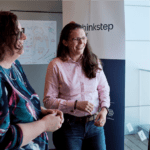What does ‘sustainable manufacturing’ actually involve?
In April issue of NZ Manufacturer www.nzmanufacturer.co.nz we talk with Emily Townsend, Services Director, thinkstep-anz. Emily’s spent her career working in manufacturing, and with manufacturers, in New Zealand and the UK.
 Emily, what does ‘sustainable manufacturing’ mean to you?
Emily, what does ‘sustainable manufacturing’ mean to you?
It’s become a buzzword but I think it’s about change – incremental and major. Incremental change involves things like producing more efficiently and ensuring products create less waste at their end-of-life.
Major change is about powering factories with renewable energy and moving to responsible procurement to avoid modern slavery in supply chains.
People need manufactured products and it’s unrealistic to think those needs will go away. So the challenge for manufacturers is to reduce the impacts of your products.
When did you get into sustainable manufacturing?
At the start of my career (though it wasn’t called sustainability then!) In my first role I supported a bid to supply to the London Olympics. I had to find out what our business was doing to meet their criteria, then coordinate and communicate our work.
I also helped measure the carbon footprint of the M25 motorway that circles London. I looked at options like recycled asphalt to reduce the footprint and produced a tool for the industry to assess options.
I then worked in roles in lean manufacturing, measured products’ carbon footprints and reported on sustainability performance. When I came to New Zealand in 2015 I took up a sustainability role with Downer. (Sustainability was a term by then!) I joined thinkstep-anz in 2018.
What does your current role involve?
I support our thinkstep-anz team to deliver sustainability projects to clients, including many manufacturers. Are we meeting technical best practice? Delivering what our clients need? Linking our services for greatest impact?
How do manufacturers benefit from becoming more sustainable?
You’ll understand your product, processes and value chain better. That often highlights ways to become more productive and profitable. You’ll also reduce risks and strengthen relationships with stakeholders, including your team.
How has your team helped manufacturers make their products more sustainable?
Golden Bay Cement is a good example. We used a tool called Life Cycle Assessment to measure the environmental impacts of their cement, then supported the company to communicate those impacts in an Environmental Product Declaration (EPD).
An EPD tells a product’s environmental story over its life cycle. It’s science-based, independently verified and publicly available.
Later we used scenarios to test what would happen if Golden Bay Cement changed their production processes and updated the EPD to report the improvements.
And their packaging?
If you manufacture packaging, you may know about our work here. We’ve measured the carbon footprints of many packaging options: punnets for Meadow Mushrooms’ mushrooms, various options for Zespri’s kiwifruit, postbags for NZ Post and cartons for Tetra Pak.
Where should manufacturers start to become more sustainable?
Do a ‘materiality assessment’. This involves asking your stakeholders about the social, environmental and economic topics that matter most to them, then putting a ‘business lens’ over these topics to understand what’s most relevant to your business.
Some topics are relevant to most manufacturers. For example, social topics will include your team’s health and safety. Environmental topics will include your discharges to air and water, your impact on climate change, and the risks of a changing climate to your business.
Then there are the economic topics. How circular and durable are your products? How resilient is your supply chain?
Why do manufacturers need to work with their supply chains to become more sustainable?
For many manufacturers, the bulk of your impacts are in your supply chain. They come from extracting and processing the raw materials you use and transporting them to your factory. Understanding how your suppliers operate and working with them to be more efficient or develop lower-impact products can have a huge effect on the impacts of the finished products you manufacture.
Think beyond environmental. Supply chains are complex. It can be hard to understand exactly where your materials come from and harder to know the work practices involved. Could your materials come from a conflict zone? Could there be modern slavery such as child labour involved? Developing a responsible procurement strategy will help you identify and minimise these risks.
How are industry associations supporting manufacturers to become more sustainable?
Concrete NZ is a good example. We’ve helped them develop a decarbonisation roadmap for their industry. It summarises what needs to happen, how and when for the concrete industry to be ‘net-zero carbon’ by 2050.
Roadmaps make sure everyone in the industry understands what needs to happen and build momentum for change.
How can manufactures show progress without risking ‘greenwash’?
Base your decisions and reporting on data and get your data and claims reviewed independently. Produce an EPD – it’s a document your customers can trust.
And consider product certification through an industry scheme to show you’re following industry best practice.



